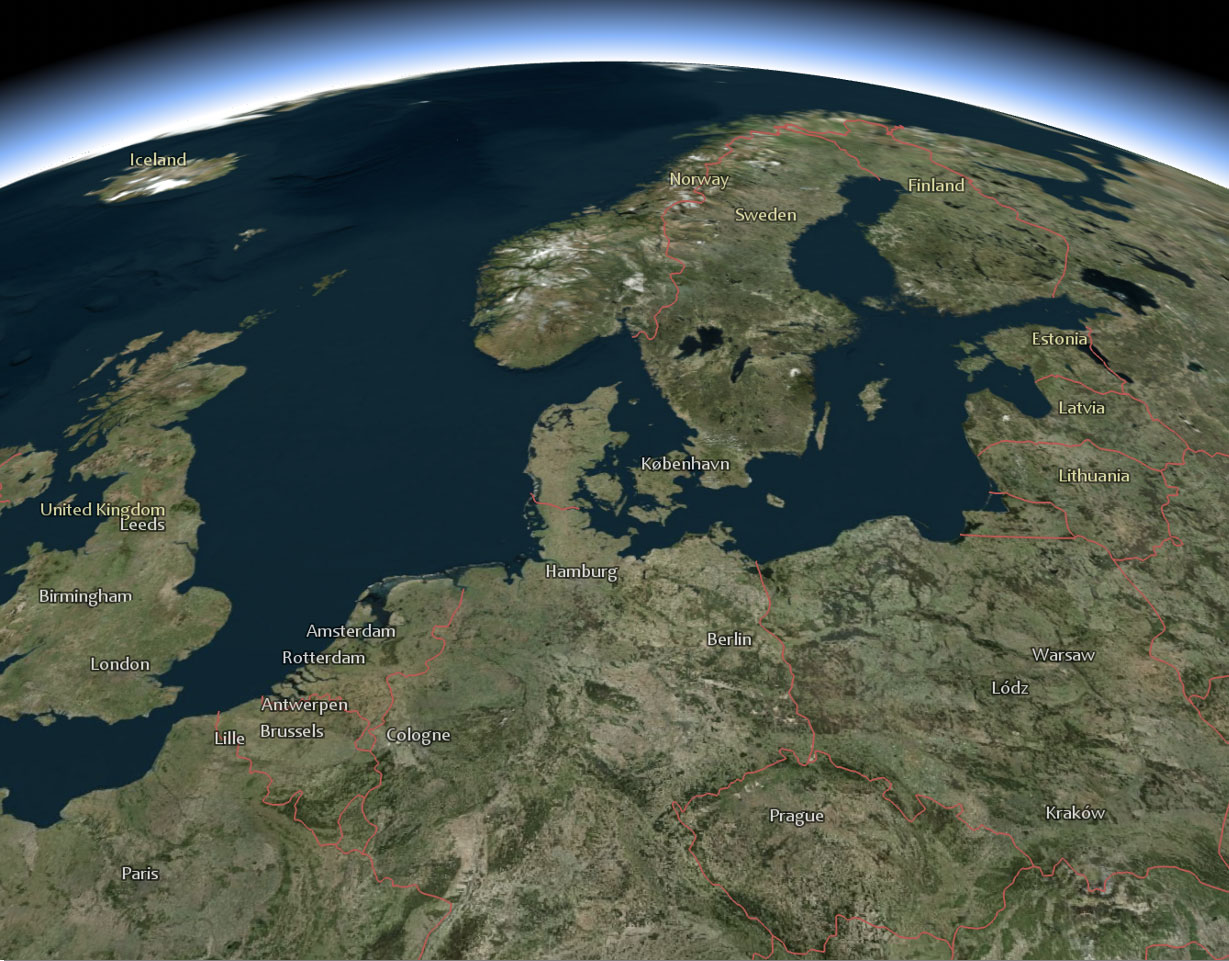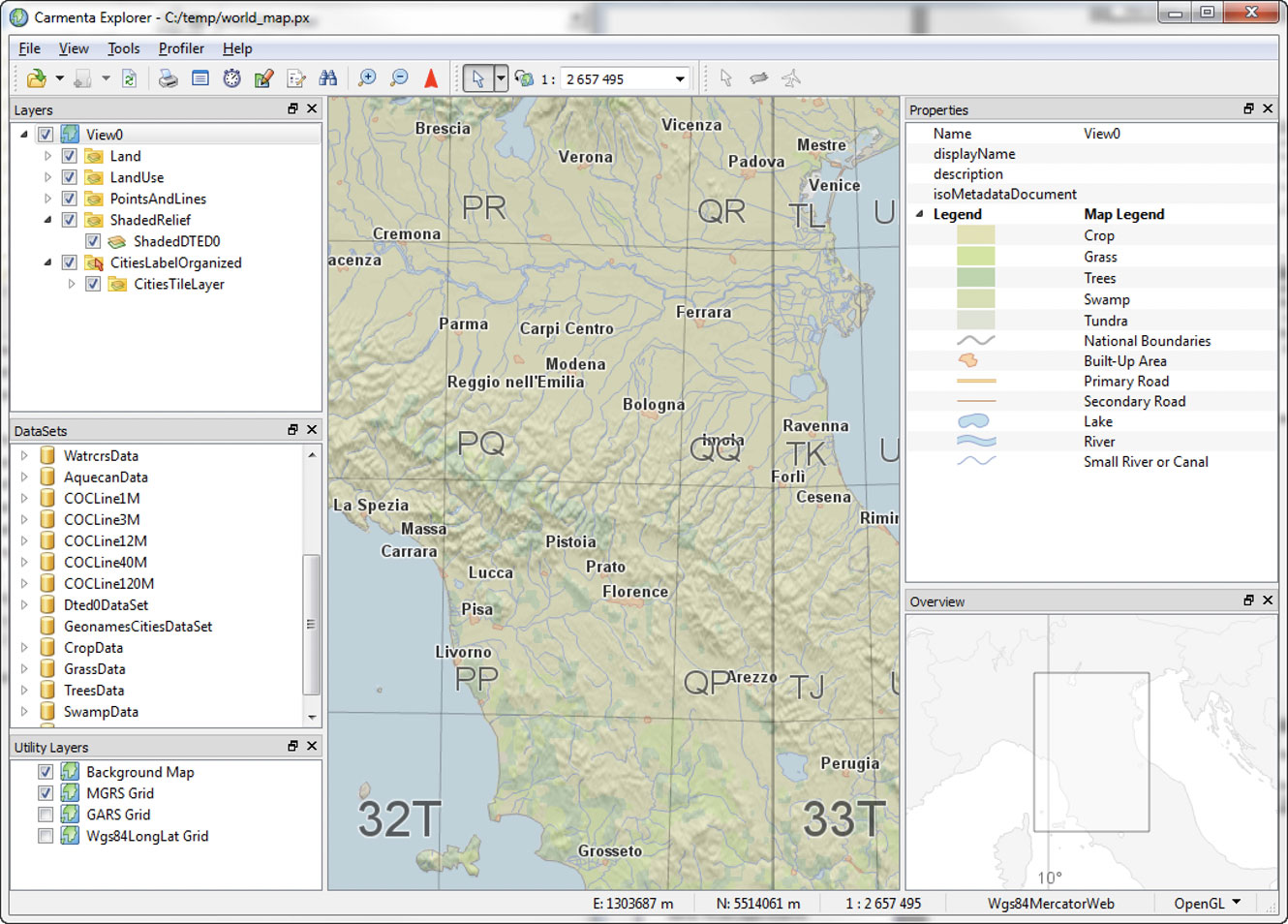Carmenta Engine 5.8
The new version of Carmenta Engine provides many improvements in the support for 3D maps, as well as an optimized way to georeference and overlay full motion video streams from UAVs or other sources.
Other major improvements include a hardware accelerated terrain warning display and new data exploration features in Carmenta Explorer.
Seamless, Global 3D Maps
The new GlobeView component renders the map on a seamless globe where data is dynamically loaded in the appropriate resolution depending on the position and altitude of the camera.
Other 3D improvements in this version include a much easier way to generate 3D features from 2D geospatial data, such as airspace volumes from 2D airspaces or spheres that indicate the maximum range around threats in a tactical overlay.

A screenshot from the new 3D globe included as a sample configuration in Carmenta Engine 5.8.
Real Time Terrain Warning Display
The new terrain warning component makes it easy to apply a configurable color coded terrain awareness and warning visualization in both 2D and 3D GlobeView maps, e.g. for simulation or rehearsal purposes.
When using hardware accelerated rendering, the terrain warning visualization is performed entirely on the graphics card. This means it can be continuously updated as the aircraft position and altitude changes, with virtually zero impact on the overall performance of the application.

The new terrain warning visualization in action in a 3D GlobeView map.
Georeferenced Full Motion Video
The new CameraProjectOperator can be used to project non-georeferenced imagery such as a video stream onto the ground in real time, based on camera parameters.
The new component has been designed to be easy to integrate with video and metadata streams in any format.
A programming sample is provided that explain how to use georeferencing metadata to overlay a video stream onto the map, this metadata could be extracted from a video stream encoded in accordance with the Motion Imagery Standards Board (MISB) 0601 and NATO STANAG 4609 standards.

A screenshot from the new ProjectedVideo SDK sample, showing a projected video stream playing on top of OpenStreetMap vector data.
Qt Quick Integration
Qt Quick is a modern C++ user interface technology that separates the declarative UI design and the imperative programming logic. The new QtQuickMapControl makes it easy to use Carmenta Engine with full hardware acceleration inside Qt Quick applications.
This further affirms Carmenta Engine as the number one choice for Qt based advanced geospatial applications.

A screenshot from the new Qt Quick “hello world” application
included as a sample in Carmenta Engine 5.8.
Improvements to Carmenta Explorer
In Carmenta Engine 5.8, Carmenta Explorer has gone from a simple map configuration viewer to a data exploration tool.
You can now open geographical data files directly in Carmenta Explorer – you no longer need to start by defining a map configuration file for the data in Carmenta Studio.
Additionally, the properties panel has been updated to make it possible to inspect the properties of loaded DataSets.
It is now also possible to let Carmenta Explorer display utility layers like a low-resolution background map and various map grids together with the loaded map.

A screenshot of the improved Carmenta Explorer application
displaying the “world map” sample configuration.
Other Notable Improvements
Fully Tested on Windows 10
Carmenta Engine 5.8 is the first Carmenta Engine version to be tested and fully supported on Microsoft Windows 10.
Android Studio Support
Carmenta Engine for Android now has full support for the Android Studio development environment. All code samples and tutorials have been updated for Android Studio.
Global Area Reference System (GARS)
Carmenta Engine now supports GARS, the Global Area Reference System defined by NGA. The GarsGridGenerator can be used to display a GARS grid on the map and utility methods makes it easy to work with GARS-formatted strings.
Improved Text Formatting
The TextVisualizer expression syntax has been extended with many new text formatting methods. The new interpolated string functionality provides an efficient way to define
text labels.
Efficient Rendering of Overlapping Map Layers
Applications that have been configured to use many overlapping, opaque map layers will benefit from a new optimization which can automatically ensure that only the topmost layer is rendered.
C++ Debug Visualization
The Carmenta Engine SDK now includes ‘natvis’ files which provide debug visualization of objects in the C++ API in Visual Studio 2013 and later.
